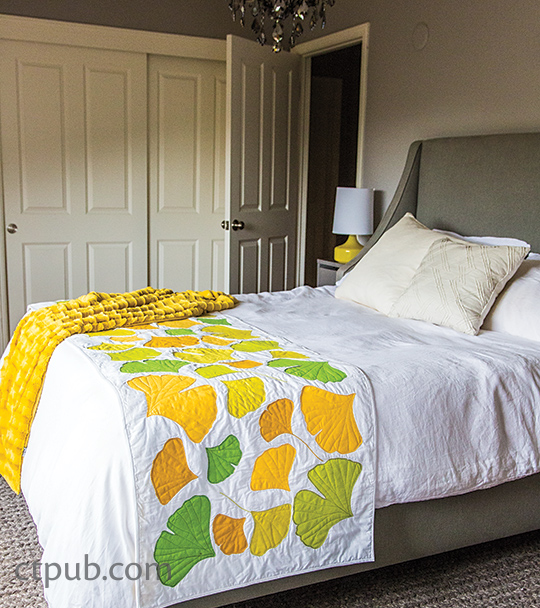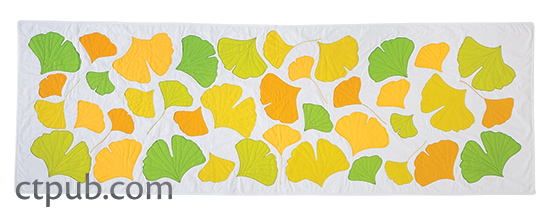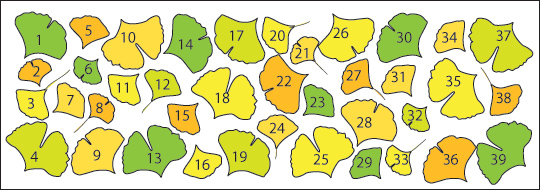Ginko Bed Runner from Casey York
Posted by Casey York on Mar 9th 2017

I love bed runners. They’re a great quilted project to dress up your bed without having to make a full-size quilt. Moreover, their smaller size makes them easier to quilt. If you wish to make a full quilt, simply follow the placement diagram but enlarge the background fabric to measure the final quilt size.

Finished size: 80˝ × 28˝
MATERIALS
Unless otherwise noted, all measurements refer to 40˝-wide 100% cotton quilting fabric.
• White: 2 1/2 yards for background OR 1 yard if fabric is 90˝+ wide
• Yellow: 1/2 yard for leaves
• Gold: 1/2 yard for leaves
• Yellow green: 1/2 yard for leaves
• Acid green: 1/2 yard for leaves
• Kelly green: 1/2 yard for leaves
• Backing: 2 1/2 yards
• Batting: 88˝ × 36˝
• Binding: 1 yard for bias binding OR 5/8 yard for straight-grain binding
• Double-sided lightweight fusible web, 15˝ wide: 3 yards
• Invisible thread
• 6-stranded cotton embroidery floss: 1 skein to match each appliqué color
• Removable fabric marker
Cutting
Refer to the Gingko patterns (download them here!) for directions on cutting the appliqués.
Tip: As you trace your patterns, also transfer the labels and color suggestions onto the paper backing of the fusible web. This way,you will have no confusion about which template to fuse to which appliqué fabric.
From the white fabric:
• On the lengthwise grain, cut a rectangle 28˝ × 80˝.
Assembling the Top
1. Refer to the appliqué placement diagram below to arrange the appliqués on the background fabric and fuse them in place.
2. Use invisible thread and a zigzag or blanket stitch to machine stitch around the edge of each appliqué.

Appliqué placement diagram—Leave at least 1 1/2˝ on all edges of the background fabric to allow enough room for the binding.
Embroidering the Appliqués
1. Finish the raw edges of the appliqués by encasing them beneath a line of hand embroidery. Use 3 strands of 6-stranded cotton embroidery thread in a color that matches each appliqué.
2 Using a removable fabric marker, transfer the stem pattern to the ends of leaves 3, 8, 12, 20, 21, 24, 27, 33, and 38. Note that the stem pattern is not reversed and should be transferred as is to the background fabric. Embroider the stems using a chain stitch and 3 strands of floss in a color that matches the appliqué fabrics.
Casey’s Tips
Adding embroidery around your appliqués protects the raw edges and also lends them additional textural interest. Although I usually prefer to use three strands of six-stranded floss in a color that matches my appliqué fabric, you can achieve wonderful results by using contrasting colors and different types and textures of thread, such as perle cotton.
Finishing
1. Layer, baste, and quilt as desired.
2. Use your preferred method to make and attach the binding.
3 If you plan to hang the quilt, add a sleeve.
Casey York is a quilt designer and author known for her bold, minimalist appliqué quilts.







